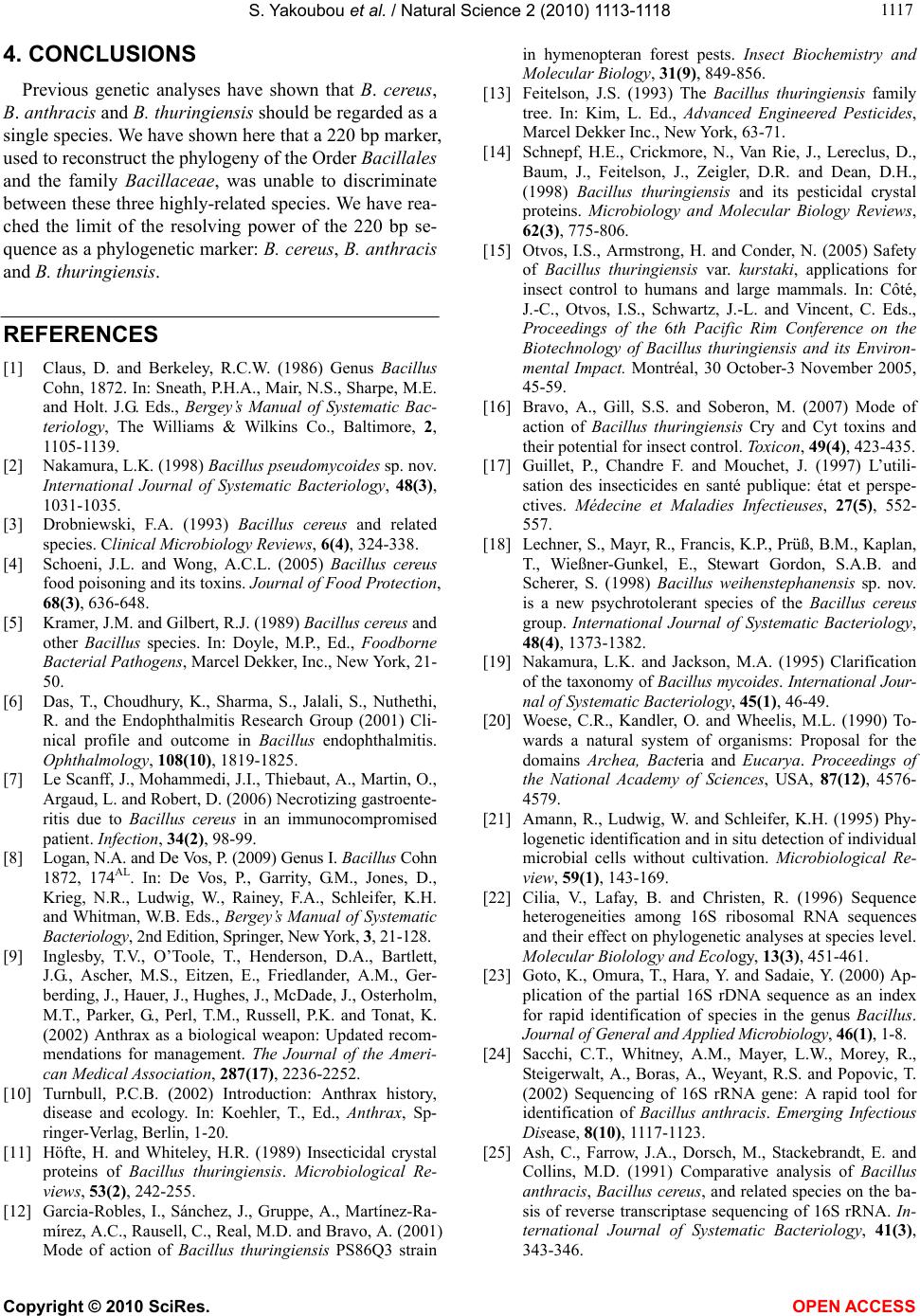
S. Yakoubou et al. / Natural Science 2 (2010) 1113-1118
Copyright © 2010 SciRes. OPEN ACCESS
111
1117
4. CONCLUSIONS
Previous genetic analyses have shown that B. cereus,
B. anthracis and B. thuringiensis should be regarded as a
single species. We have shown here that a 220 bp marker,
used to reconstruct the phylogeny of the Order Bacillales
and the family Bacillacea e, was unable to discriminate
between these three highly-related species. We have rea-
ched the limit of the resolving power of the 220 bp se-
quence as a phylogenetic marker: B. cereus, B. anthracis
and B. thuringiensis.
REFERENCES
[1] Claus, D. and Berkeley, R.C.W. (1986) Genus Bacillus
Cohn, 1872. In: Sneath, P.H.A., Mair, N.S., Sharpe, M.E.
and Holt. J.G. Eds., Bergey’s Manual of Systematic Bac-
teriology, The Williams & Wilkins Co., Baltimore, 2,
1105-1139.
[2] Nakamura, L.K. (1998) Bacillus pseudomycoides sp. nov.
International Journal of Systematic Bacteriology, 48(3),
1031-1035.
[3] Drobniewski, F.A. (1993) Bacillus cereus and related
species. Clinical Microbiology Reviews, 6(4), 324-338.
[4] Schoeni, J.L. and Wong, A.C.L. (2005) Bacillus cereus
food poisoning and its toxins. Journal of Food Protection,
68(3), 636-648.
[5] Kramer, J.M. and Gilbert, R.J. (1989) Bacillus cereus and
other Bacillus species. In: Doyle, M.P., Ed., Foodborne
Bacterial Pathogens, Marcel Dekker, Inc., New York, 21-
50.
[6] Das, T., Choudhury, K., Sharma, S., Jalali, S., Nuthethi,
R. and the Endophthalmitis Research Group (2001) Cli-
nical profile and outcome in Bacillus endophthalmitis.
Ophthalmology, 108(10), 1819-1825.
[7] Le Scanff, J., Mohammedi, J.I., Thiebaut, A., Martin, O.,
Argaud, L. and Robert, D. (2006) Necrotizing gastroente-
ritis due to Bacillus cereus in an immunocompromised
patient. Infection, 34(2), 98-99.
[8] Logan, N.A. and De Vos, P. (2009) Genus I. Bacillus Cohn
1872, 174AL. In: De Vos, P., Garrity, G.M., Jones, D.,
Krieg, N.R., Ludwig, W., Rainey, F.A., Schleifer, K.H.
and Whitman, W.B. Eds., Bergey’s Manual of Systematic
Bacteriology, 2nd Edition, Springer, New York, 3, 21-128.
[9] Inglesby, T.V., O’Toole, T., Henderson, D.A., Bartlett,
J.G., Ascher, M.S., Eitzen, E., Friedlander, A.M., Ger-
berding, J., Hauer, J., Hughes, J., McDade, J., Osterholm,
M.T., Parker, G., Perl, T.M., Russell, P.K. and Tonat, K.
(2002) Anthrax as a biological weapon: Updated recom-
mendations for management. The Journal of the Ameri-
can Medical Association, 287(17), 2236-2252.
[10] Turnbull, P.C.B. (2002) Introduction: Anthrax history,
disease and ecology. In: Koehler, T., Ed., Anthrax, Sp-
ringer-Verlag, Berlin, 1-20.
[11] Höfte, H. and Whiteley, H.R. (1989) Insecticidal crystal
proteins of Bacillus thuringiensis. Microbiological Re-
views, 53(2), 242-255.
[12] Garcia-Robles, I., Sánchez, J., Gruppe, A., Martínez-Ra-
mírez, A.C., Rausell, C., Real, M.D. and Bravo, A. (2001)
Mode of action of Bacillus thuringiensis PS86Q3 strain
in hymenopteran forest pests. Insect Biochemistry and
Molecular Biology, 31(9), 849-856.
[13] Feitelson, J.S. (1993) The Bacillus thuringiensis family
tree. In: Kim, L. Ed., Advanced Engineered Pesticides,
Marcel Dekker Inc., New York, 63-71.
[14] Schnepf, H.E., Crickmore, N., Van Rie, J., Lereclus, D.,
Baum, J., Feitelson, J., Zeigler, D.R. and Dean, D.H.,
(1998) Bacillus thuringiensis and its pesticidal crystal
proteins. Microbiology and Molecular Biology Reviews,
62(3), 775-806.
[15] Otvos, I.S., Armstrong, H. and Conder, N. (2005) Safety
of Bacillus thuringiensis var. kurstaki, applications for
insect control to humans and large mammals. In: Côté,
J.-C., Otvos, I.S., Schwartz, J.-L. and Vincent, C. Eds.,
Proceedings of the 6th Pacific Rim Conference on the
Biotechnology of Bacillus thuringiensis and its Environ-
mental Impact. Montréal, 30 October-3 November 2005,
45-59.
[16] Bravo, A., Gill, S.S. and Soberon, M. (2007) Mode of
action of Bacillus thuringiensis Cry and Cyt toxins and
their potential for insect control. Toxicon, 49(4), 423-435.
[17] Guillet, P., Chandre F. and Mouchet, J. (1997) L’utili-
sation des insecticides en santé publique: état et perspe-
ctives. Médecine et Maladies Infectieuses, 27(5), 552-
557.
[18] Lechner, S., Mayr, R., Francis, K.P., Prüß, B.M., Kaplan,
T., Wießner-Gunkel, E., Stewart Gordon, S.A.B. and
Scherer, S. (1998) Bacillus weihenstephanensis sp. nov.
is a new psychrotolerant species of the Bacillus cereus
group. International Journal of Systematic Bacteriology,
48(4), 1373-1382.
[19] Nakamura, L.K. and Jackson, M.A. (1995) Clarification
of the taxonomy of Bacillus mycoides. International Jour-
nal of Systematic Bacteriology, 45(1), 46-49.
[20] Woese, C.R., Kandler, O. and Wheelis, M.L. (1990) To-
wards a natural system of organisms: Proposal for the
domains Archea, Bacteria and Eucarya. Proceedings of
the National Academy of Sciences, USA, 87(12), 4576-
4579.
[21] Amann, R., Ludwig, W. and Schleifer, K.H. (1995) Phy-
logenetic identification and in situ detection of individual
microbial cells without cultivation. Microbiological Re-
view, 59(1), 143-169.
[22] Cilia, V., Lafay, B. and Christen, R. (1996) Sequence
heterogeneities among 16S ribosomal RNA sequences
and their effect on phylogenetic analyses at species level.
Molecular Biolology and Ecology, 13(3), 451-461.
[23] Goto, K., Omura, T., Hara, Y. and Sadaie, Y. (2000) Ap-
plication of the partial 16S rDNA sequence as an index
for rapid identification of species in the genus Bacillus.
Journal of General and Applied Microbiology, 46(1 ), 1-8.
[24] Sacchi, C.T., Whitney, A.M., Mayer, L.W., Morey, R.,
Steigerwalt, A., Boras, A., Weyant, R.S. and Popovic, T.
(2002) Sequencing of 16S rRNA gene: A rapid tool for
identification of Bacillus anthracis. Emerging Infectious
Disease, 8(10), 1117-1123.
[25] Ash, C., Farrow, J.A., Dorsch, M., Stackebrandt, E. and
Collins, M.D. (1991) Comparative analysis of Bacillus
anthracis, Bacillus cereus, and related species on the ba-
sis of reverse transcriptase sequencing of 16S rRNA. In-
ternational Journal of Systematic Bacteriology, 41(3),
343-346.